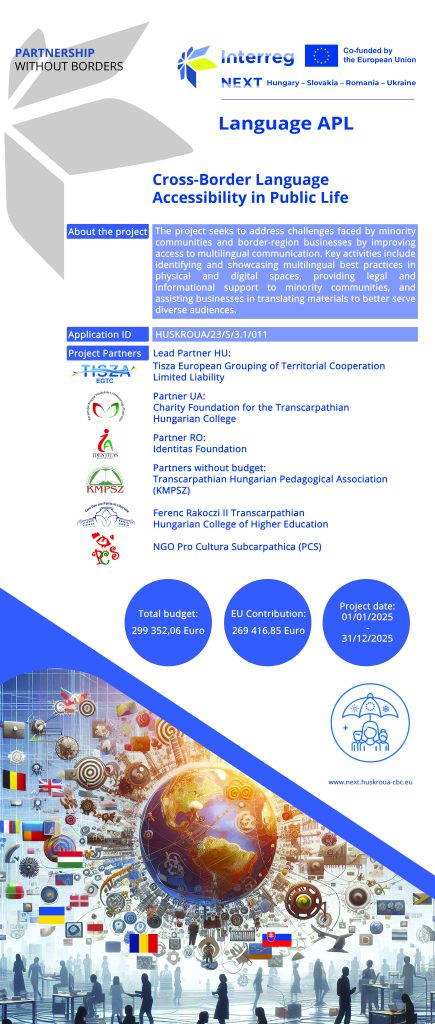In accordance with European Union directives, all initiatives that promote accessibility (European Accessibility Act[1]) and border interoperability (FRONTEX: The European Border and Coast Guard Agency[2]) are supported. The Interreg Europe[3] program was established in line with the enlargement policy of the EU, with the aim of reducing the differences in development, growth and quality of life across regions within the EU, as well as in the border areas of candidate countries, through the projects it finances.

The aim of the project:
As a result of historical changes along the Hungarian–Ukrainian–Romanian border and the transformation of state borders, numerous minority groups now reside within the territories of neighbouring countries. Additionally, following the outbreak of the Russo–Ukrainian war, a significant number of Ukrainian citizens have relocated to the member states of the European Union, particularly to those neighbouring Ukraine. The existence of minority groups within nation-states largely depends on the opportunities offered in the territory of the given country for using the language of the minority or the neighbouring state. One of the key milestones in the establishment of the European Union was the protection of minority languages, which led to the adoption of the European Charter for Regional or Minority Languages[4]. This emphasis on language protection emerged from the recognition that language-related issues often served as significant triggers for international conflicts in Europe. Another important aspect is that the interoperability of borders is intended to encourage economic cooperation, and the promotion of successful cooperation in most cases depends on effective communication. It is evident that businesses operating in border regions frequently experience a loss of clients because they publish information exclusively in a single language (typically in the official state language). To address this issue, our goal is to promote multilingualism, taking into account the needs of potential visitors from other regions.

The objective of our project therefore focuses on two important areas:
- Firstly, the enforcement of minority rights and the promotion of minority language use within the European Union and in its neighbouring regions;
- Secondly, the encouragement of economic cooperation through the facilitation of linguistic diversity.
The following activities will be implemented during the project:
- We will identify locations in both physical and digital spaces, within official and private sectors, where linguistic diversity is evident. From these, we will select five multilingual locations that exemplify best practices in implementing language accessibility in the given region;
- We will inform minority communities about their rights and the opportunities available to them within the given country. For instance, we will create brochures summarizing key legislation and, in other cases, provide legal assistance via telephone to residents;
- We will offer five selected businesses or office locations in each country the opportunity to translate their signs, announcements, and informational materials associated with the physical or digital spaces of the given locations (advertisements, brochures, menus, flyers, etc.);
- Finally, we will organize a conference in Berehove, at the Ferenc Rákóczi II Transcarpathian Hungarian College of Higher Education, where the research team involved in the project will present their findings and experiences, and international specialists will be invited to illustrate and interpret best practices from countries where the public display of multilingualism has been successfully implemented.
From the Ukrainian side, the Antal Hodinka Linguistic Research Center, operating on the basis of the Ferenc Rákóczi II Transcarpathian Hungarian College of Higher Education, is involved in the implementation of the project, which has previously launched several similar initiatives, primarily examining the use of the Hungarian language in both official and private spheres (see: https://hodinkaintezet.uz.ua/kutatasi-programok/lathato-es-mukodo-ketnyelvuseg-2011/). The main conclusions of the research indicate a significant demand for the use of the Hungarian language in official contexts among Transcarpathian Hungarians. Additionally, a notable demand for multilingualism has emerged in the private sector, driven by historical transformations.
Implementation period: January 1, 2025 – December 31, 2025.
Lead beneficiary of the project:
HU: Tisza Korlátolt Felelősségű Európai Területi Társulás / Tisza European Grouping of Territorial Cooperation Limited Liability[5]
Collaborating partners:
UA: Благодійний Фонд за Закарпатський угорський інститут / Kárpátaljai Magyar Főiskoláért Jótékonysági Alapítvány/ Charity Foundation for the Transcarpathian Hungarian College[6]
Закарпатське угорськомовне педагогічне товариство / Kárpátaljai Magyar Pedagógusszövetség / Transcarpathian Hungarian Pedagogical Association (KMPSZ)
Закарпатський угорський інститут ім. Ференца Ракоці ІІ / II. Rákóczi Ferenc Kárpátaljai Magyar Főiskola / Ferenc Rákóczi II Transcarpathian Hungarian College of Higher Education
Громадська організація «Про Культура Субкарпатіка» / Pro Cultura Subcarpathica (PCS) civil szervezet / NGO Pro Cultura Subcarpathica (PCS)
RO: Fundaţia Identitás Alapítvány, Szatmárnémeti
The total budget of the project: 299,352.06 EUR
Amount of EU funding: 269,416.85 EUR
[1] https://employment-social-affairs.ec.europa.eu/policies-and-activities/social-protection-social-inclusion/persons-disabilities/union-equality-strategy-rights-persons-disabilities-2021-2030/european-accessibility-act_en?prefLang=hu
[2] https://home-affairs.ec.europa.eu/agencies_en#ecl-inpage-783
[3] https://www.interregeurope.eu/
[4] https://www.coe.int/en/web/european-charter-regional-or-minority-languages/text-of-the-charter
[6] https://kmf.uz.ua/hu/tag/karpataljai-magyar-foiskolaert-jotekonysagi-alapitvany/
